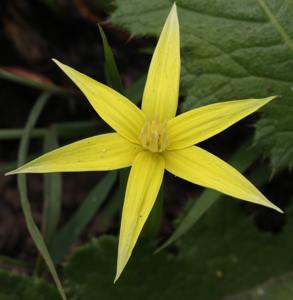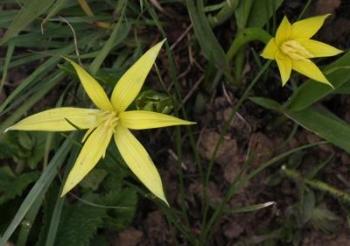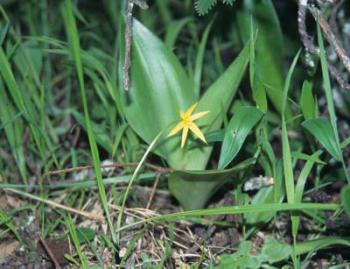Empodium elongatum
Empodium elongatum (Nel) B.L.Burtt
Family: Hypoxidaceae
Common names: autumn star
Introduction
Autumn stars, elusive among grasses, are spotted by their bright yellow starry flowers.

Description
Description
Empodium elongatum is a small geophytic herb, 150-200 mm tall, growing solitarily. Plants are anchored by a small subglobose corm, buried deep. One to four leaves develop with the flowers and elongate after flowering. Leaves are long and narrow, 150-250 mm long x 3-4 mm wide, glabrous or sparsely hairy on ribs and margins, bases wrapped in remains of old brown leaves.
Inflorescences vary from two to six per plant, each with a single flower on a short pedicel hidden in the leaf sheaths. Flowers are star-like, yellow and without a scent; tepals 6, narrowly ovate, lightly green and glabrous on the back. Anthers linear and held close together, on short filaments arising from tepal base. The ovary is shortly exserted with one locule and extends upwards into a well-developed solid tube, 30-90 mm long (referred to as beak). Fruit is an indehiscent capsule, subsucculent to thin-walled when ripe, disintegrating irregularly from apex, aerial or below ground. Seeds round, black, warty and shiny. Plants flower from October to January with a peak in November.

Conservation Status
Status
Least Concern (LC).
Distribution and habitat
Distribution description
Empodium elongatum is endemic to southern Africa. It is found in the Free State, KwaZulu-Natal, Mpumalanga, Gauteng, Lesotho and Swaziland. The species grows in grassland, in well-drained to seasonally moist loam or clay soil, in full sun or semi-shade. It occurs at high altitudes of 1500-2500m above sea leavel.

Derivation of name and historical aspects
History
Empodium is derived from the Greek em- meaning within and pous meaning foot referring to the underground ovary. The specific epithet elongatum refers to the long beak-like extension of the ovary. The species was described by Gert Nel in 1914 as Forbesia elongata and later transferred to Empodium.
Empodium is a small genus of eight species, endemic to southern Africa. The genus occurs in South Africa, Lesotho, Swaziland, but is absent from Namibia and Botswana. Most species are found in the winter rainfall region of South Africa. Empodium is recognized by a combination of characters. These include a corm, linear to lanceolate leaves often pleated, inflorescence with a single flower, lacking bracts and with a solid tube (beak) between ovary and tepals, tepals yellow and free, ovary usually hidden in leaf sheaths, and unilocular and fruit an indehiscent capsule.
Empodium belongs in the Hypoxidaceae, a family better-known for Hypoxis (star-fower) and Rhodohypoxis (red stars). The genera Heliacme, Hypoxi, Hypoxidia, Molineria, Pauridia (includes Saniella and Spiloxene ), Curciligo and Sinocurciligo (recent addition) are also placed in the Hypoxidaceae.
Ecology
Ecology
Virtually nothing is known about the ecology of the genus, its response to fire or pollination. The species is possibly pollinated by bees.
Uses
Use
Empodium elongatum has no reported uses as a medicinal or horticultural plant.
E. plicatum, known as golden star, ploegtydblommetjie, sterretjie (Afr), isidwa, esincane senkangala (Z) is reported to be used by the Zulu people. Decoctions of the rootstock of E. plicatum are taken for chest trouble thought to be caused by evil charms or poison.
Growing Empodium elongatum
Grow
Empodium elongatum is not known in cultivation. Related species, E. gloriosum and E. plicatum are grown in the United Kingdom as pot plants but not to the same extent as Rhodohypoxis. Plants in cultivation like well-drained, fertile soil, in full or dapple sun. Frost free conditions are required.
References
- Hilliard, O.M. & Burtt, B.L. 1978. Notes on some plants of southern Africa chiefly from Natal: 7: 233-244. Rhodohypoxis . Notes from the Royal Botanic Garden, Edinburgh 36: 43-76.
- Hutchings, A., (with Scott, A.H., Lewis, G. & Cunningham, A.B.) 1996. Zulu Medicinal Plants: an inventory . University of Natal Press, Pietermaritzburg.
- Nel, G.C. 1914. Die afrikanischen Arten der Amaryllidaceae-Hypoxideae. In A.
- Engler. Beiträge zur Flora von Afrika: 43. Botanische Jahrbücher 51: 287-340.
- Raimondo, D., Von Staden, L., Foden, W., Victor, J.E., Helme, N.A., Turner, R.C., Kamundi, D.A. & Manyama, P.A. (eds). Red List of South African plants 2009. Strelitzia 25. South African National Biodiversity Institute, Pretoria. http://redlist.sanbi.org/species.php?species=1605-1.
Credits
Ndivhuwo Mahvungu and Yashica Singh
KwaZulu-Natal Herbarium
October 2013
Plant Attributes:
Plant Type: Bulb
SA Distribution: Free State, Gauteng, KwaZulu-Natal, Mpumalanga
Soil type: Clay, Loam
Flowering season: Spring, Early Summer
PH: Acid, Neutral
Flower colour: Yellow
Aspect: Full Sun, Morning Sun (Semi Shade), Afternoon Sun (Semi Shade)
Gardening skill: Challenging
Special Features:
Horticultural zones









Rate this article
Article well written and informative
Rate this plant
Is this an interesting plant?
Login to add your Comment
Back to topNot registered yet? Click here to register.